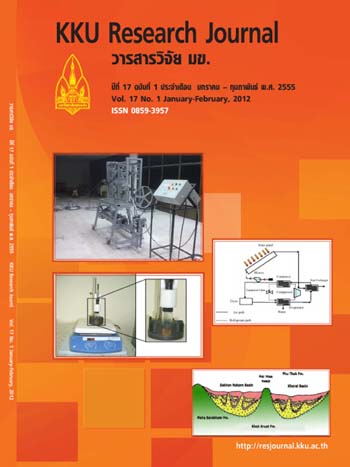Inulin and Fructooligosacharides in different varieties of jerusalem artichoke (Helianthus tuberosus L.)
Main Article Content
Abstract
This study aimed to determine the amounts of inulin and fructo-oligosaccharides [FOS; 1-kestose (1-kestotriose, GF2), nystose (1, 1-kestotetraose, GF3), and 1F-β-fructofuranosylnystose (1,1,1-kestopentaose, GF4)] in 16 varieties of Jerusalem artichoke (Helianthus tuberosus L.) or Kaentawan. These varieties were bred and developed by Khon Kaen University. One kilogram of each variety was collected and sent to Institute of Nutrition, Mahidol University for inulin and FOS analyses. Each variety was divided into two portions before sample preparation; first portion was prepared as edible part with skin and another portion without skin. Inulin and FOS were extracted with hot water, digested with inulinase and determined by gas chromatography. All varieties of Kaentawan, with skin or without skin, contained inulin at the same range, from 14.0 to 20.4 g/100 g fresh weight, FW. Potential varieties of Kaentawan in terms of high inulin were JA 38 and CN 52867 varieties (79.2-84.9 and 70.5-77.6 g/100g dry weight). FOS ranged from 3.0 to 6.6 g/100 g FW which contributed to 19-40% of the inulin level. Potential varieties of Kaentawan in terms of high FOS were found in HEL 69 and JA 38 varieties (20.8-23.3 and 20.9-22.7 g/100g dry weight). Kaentawan contained low level of total sugars, less than 3.5 g/100 g FW in all varieties. There are no significant different (p>0.05) of inulin, GF-3, GF-4 and sum FOS contents in Kaentawan with or without skin. All varieties of Kaentawan are excellent sources of inulin.
Article Details
How to Cite
Tanjor, S., Judprasong, K., Chaito, C., & Jogloy, S. (2017). Inulin and Fructooligosacharides in different varieties of jerusalem artichoke (Helianthus tuberosus L.). Asia-Pacific Journal of Science and Technology, 17(1), 25–34. retrieved from https://so01.tci-thaijo.org/index.php/APST/article/view/82811
Section
Research Articles


